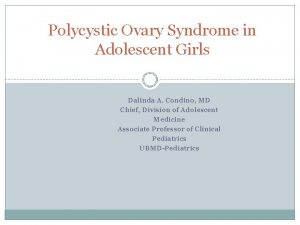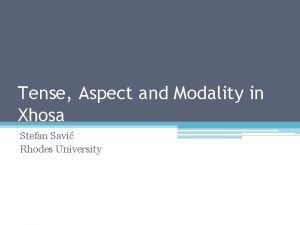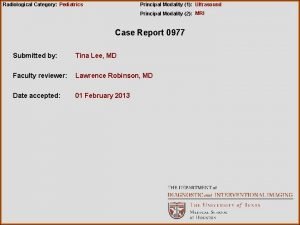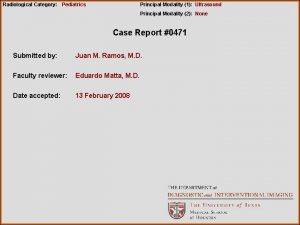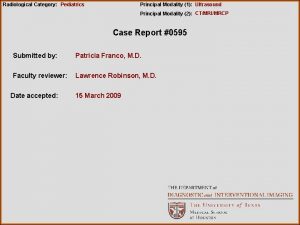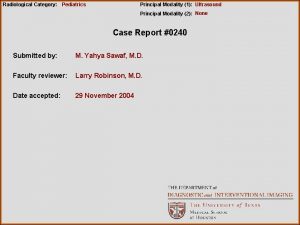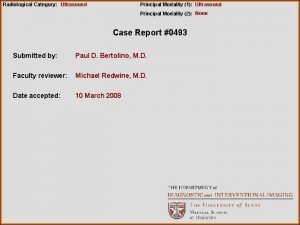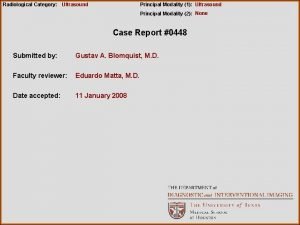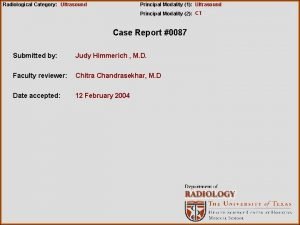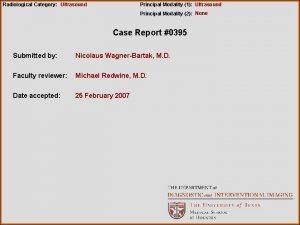Radiological Category Pediatrics Principal Modality 1 Ultrasound Principal










- Slides: 10

Radiological Category: Pediatrics Principal Modality (1): Ultrasound Principal Modality (2): None Case Report #0057 Submitted by: Jennifer Brien, M. D. Faculty reviewer: Lawrence Robinson, M. D. Date accepted: 14 January 2004

Case History Two week old male presents with persistent progressive nonbilious vomiting.

Radiological Presentations Longitudinal subxiphoid view of the abdomen.

Radiological Presentations Longitudinal view with measurements.

Radiological Presentations Cross sectional view of similar region.

Test Your Diagnosis Which one of the following is your choice for the appropriate diagnosis? After your selection, go to next page. • [Gastric Bezoar] • [Hypertrohpic Pyloric Stenosis] • [Midgut volvulus] • [Antral Duplication]

Findings and Differentials Findings: Sonographic images through the pylorus demonstrate an elongated pyloric canal measuring 19 mm and a thickenend pyloric muscle measuring 4. 7 mm. Of note, real time evaluation demonstrated persistent findings throughout the exam. Differentials: • Hypertrophic Pyloric Stenosis • Pylorospasm

Discussion In a 2 week old newborn, symptoms of progressive nonbilious vomiting should raise the suspicion of hypertrophic pyloric stenosis. The emesis will increase in frequency and often become projectile. Electrolyte imbalances occur with dehydration. Laboratoy abnormalities include hypokalemic metabolic alkalosis with a paradoxic aciduria. Occasionally, clinical exam will demonstrate an olive shaped mass to the right of the umbilicus as well as visualization of peristatlic wave activity progressing from the LUQ to the epigastrium. Ultrasound is the preferred imaging modality in order to directly visualize the pyloric musculature. On US, the sonolucent pyloric muscle will be hypertrophied and greater than 3 mm in single wall thickness with elongation of the pyloric canal beyond 14 mm. The differential is limited, but a pylorospasm must be excluded, as these patients are managed medically. Patient’s with spasm of the pyloric muscle typically have a muscle thickness of 2 -3 mm with eventual relaxation of the pylorus. Therefore, it is important to observe the pylroic region for several minutes to assure persistent hypertophied musculature rather than intermittent muscle spasm. Helpful Hint: Be sure the stomach is not overdistended during the ultrasound exam as this displaces the pylorus posteriorly making visualize more difficult. It may be necessary to insert a nasogastric tube to decompress the stomach to allow for appropriate visualization of this region.

Discussion References: Behrman, Richard and Kliegman, Robert. Nelson Essentials of Pediatrics, 2 nd ed. Philadelphia: W. B. Saunders Company, 1994. Brant, William and Helms, Clyde A. Fundamentals of Diagnostic Radiology, 2 nd ed. Philadelphia: Lippincott Williams & Wilkins, 1999. Dahnert, Wolfgang. Radiology Review Manuel, 4 th ed. Philadelphia: Lippincott Williams & Wilkins, 2000.

Diagnosis Hypertrophic Pyloric Stenosis.
